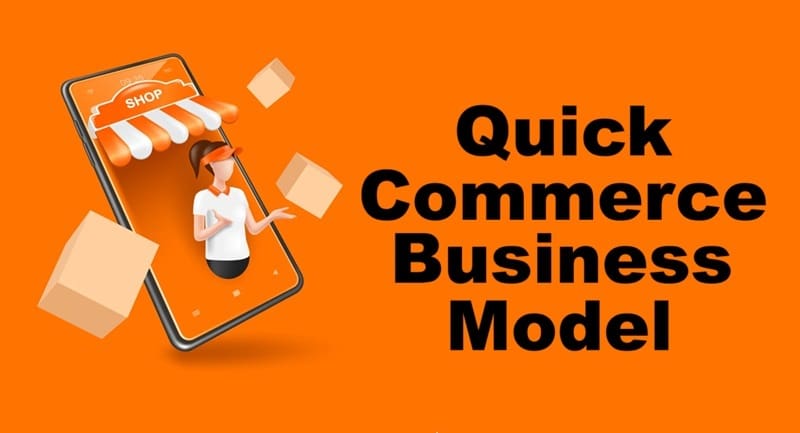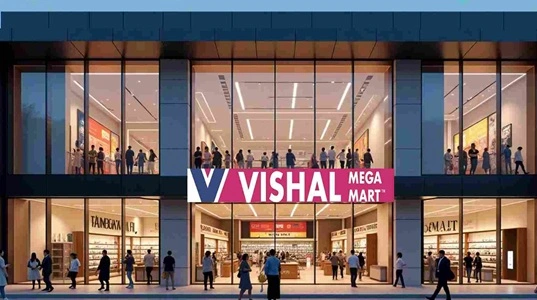The Quick Commerce Business Model is a new trend gaining immense popularity worldwide in the fast-paced world. This business strategy is also gaining acceptance in society, even in times when people have the time to visit nearby stores to buy what they want.
The core reason behind the success of the Quick Commerce Business Model is convenience with doorstep delivery. In many areas where finding a particular product is difficult in the market, the huge variety on the quick commerce platform helps customer get the product at their doorstep. Thus, the acceptance of quick commerce platforms in population-dense countries is common.
Before taking a deep dive into how this model works or what the advantages/disadvantages are, it would be a great idea to understand what the quick commerce business model is.

Quick Commerce Business Model – Definition
A quick commerce business model works on the principle of making a dark store in population-dense areas with all the essential products in it and delivering the product within ten minutes when the customer places the order. Platforms like Amazon and Flipkart are e-commerce platforms that take one to a week to deliver the product after placing the order. However, quick commerce offers the advantage of fast delivery with a huge variety of products.
How Quick Commerce Platforms Work?
The Q-commerce model combines technology, logistics, and local warehouses to make deliveries lightning fast. Here’s how it typically works:
1. Dark Stores or Micro-Warehouses
A quick commerce warehouse is usually small and situated in the centre of a town to cover a large area. The small fulfilment centre or dark stores maintain a small quantity of almost every product they sell, while ensuring a huge stock for fast-selling items.
2. Technology Integration
With the technology integration, customers can place an order through the mobile app or website. The benefit of technology is effective in managing inventory, predicting demand, and optimizing routes for the delivery agents.
3. Last Mile Delivery
Quick commerce companies use delivery partners to ensure that the product reaches customers in the shortest time possible. As we mentioned earlier, dark stores are usually located in nearby areas, and delivery riders can pick and deliver in the shortest time possible, usually within 10 to 30 minutes.
Examples of Quick Commerce Business Model
On a global scale, many e-commerce companies are creating subsidiary brands with quick commerce platforms to serve in population-dense areas. The store is usually within 5 km of range to offer fast delivery. Here are some of the top names using the quick commerce business model:
1. Blinkit
In India, Blinkit is a popular name that was formerly known as Grofers. Blinkit shifted the business model from scheduled delivery to quick commerce. Blinkit is known for great marketing, relevant advertisements, and how it promotes products.
2. Gopuff
A pioneer in the US, Gopuff delivers snacks, beverages, cleaning supplies, and over-the-counter medicines within 30 minutes, using micro-fulfilment centres.
3. Zepto
Similar to Blinkit, Zepto is also a popular quick delivery platform that started the whole Q-commerce situation in India. Zepto is known for 10-minute delivery with an immense variety and dark stores every few kilometres to serve customers better.
4. Instamart
Instamart is a product of Swiggy, well-known for competing in the quick commerce category. Swiggy originally started with the idea of food delivery, and after gaining traction, Swiggy expanded to Q-commerce, offering groceries and daily essentials within 30 minutes.
Advantages of the Quick Commerce Business Model
When e-commerce first came to market, it was a huge success, but Q-commerce has shown its strengths in the last couple of years with ultra-fast delivery. Let’s learn about the core advantages of the quick commerce business model:
1. Speed and Convenience to Customers
The major reason behind the shift from e-commerce to quick commerce is speedy delivery. Grocery items, daily essentials, and similar products are high in demand. Most people don’t want to wait for days, and they are ready to pay a small amount for the fast delivery for such convenience.
2. Competitive Edge for Business
Businesses find it easier to stand out in the already crowded e-commerce markets. Quick commerce helps brands in building loyalty because customers usually like the reliability and speed. The ability to buy and return the product in case of any issue makes Q-commerce reliable among customers.
3. Better Customer Retention
When a customer uses a quick commerce platform and gets the product within a few minutes, they are more likely to switch from buying from e-commerce to quick commerce, even if they are required to pay extra for the same service. Customer retention in quick commerce gives a competitive edge.
4. High Order Frequency
The order size in quick delivery is usually small, and it becomes possible to deliver fast this way. Due to this reason, customers order frequently, and these platforms are already working on changing customer habits.
Disadvantages of the Quick Commerce Business Model
Even though there are so many more benefits to quick commerce, there is still a dark side to it. Here are a few key things:
1. High Operational Costs
Running a Q-commerce platform is expensive for several reasons. These platforms have to maintain a huge inventory as they have a high number of dark stores. This investment increases the operational cost as compared to e-commerce platforms.
2. Thin profit Margins
The order value is small with quick commerce, and the operation cost is high. Due to these two factors, most companies are operating on a thin margin, and they prefer the franchisee business model to leave such a burden on investors.
3. Logistic and Workforce Challenge
To ensure 10 to 30-minute deliveries, companies require a strong delivery network, which can create high pressure on riders. In India, most companies pay a small cut on the delivery fees they charge to customers, and these delivery partners don’t get the benefits but get all the pressure and dissatisfaction.
Conclusion
There is a huge scope for quick commerce businesses, and the continuous expansion to new cities and areas is going to help companies generate more revenue. In the current date, most quick companies are working on small margins and making money from ads or promoting products on their platform. However, it is expected that there will be many new quick commerce platforms in the upcoming years.



